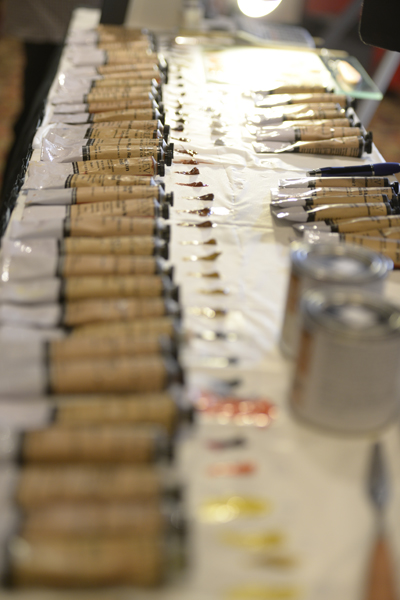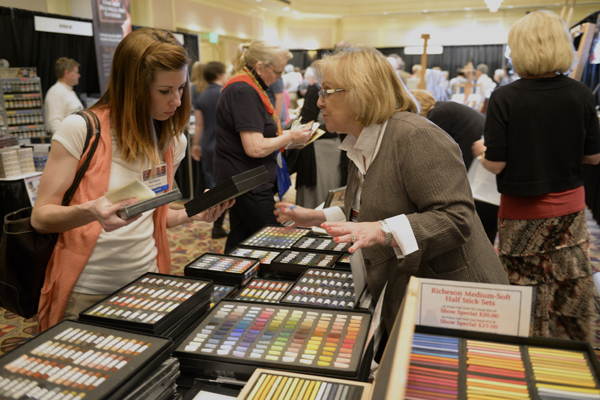 |
| Like kids in a candy store, artists busy sampling treats in the vendor's room (at the Richeson Booth) |
At 4:00 PM on April 25th, at the same moment the Art of the Portrait conference officially began, the doors to the Expo Hall opened, and fleet footed attendees ran straight to their favorite vendors to pick up more studio supplies at special conference discount prices. This year, I made sure I was among the first to enter the vendor's area, and I tried to snap a few pictures before the the aisles became too densely packed with shoppers. It is during this first hour of the conference, before the Face-Off commences, that the atmosphere in the vending area is the most hectic.
I personally love the vendor's room. Ordering supplies over the internet does not compare to having the opportunity to examine the different products up close, and to ask questions face-to-face with the passionate people who are responsible for making them. These are the items we use everyday in the studio to create our best works, after all, and I like to know as much about my materials as possible. Over the years, I have spoken to many of the sellers who participate in the Art of the Portrait events, and the personal connections I feel with these people have made me even more sure of their products and services. And that takes a big weight off my shoulders, allowing me to worry only about the quality of my painting, and not about the quality of my tools and materials.
Shopping at the conference does have its drawbacks, however, with the main problem being that it is too easy to spend over your budget once you see all the goodies. But with the all the discounts and the savings on shipping, it is difficult not feeling justified in making the purchases right on the spot.
 |
| Attendees lining up, waiting for the conference to officially begin. |
The vendors present at this year's conference were:
 |
| Silver Brush, Ltd. |
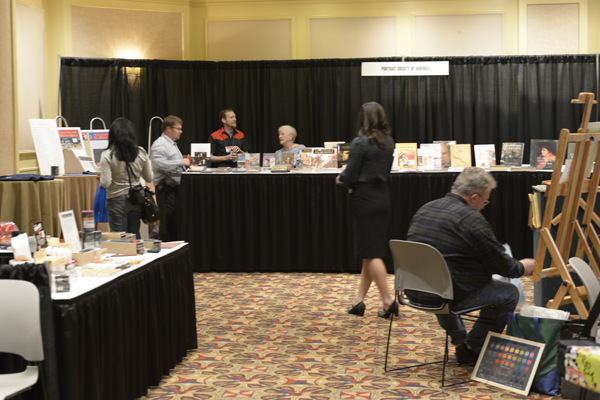 |
| General Pencil, the book table, and the Jack Richeson booth (l-r) |
I knew which sellers were going to be there this year, so I made a list of what I needed, and even allowed my supply of certain materials to run dangerously low, just so I could restock at the conference. I expected to be a the front of the line Thursday evening, fill my list, and be free from temptation the rest of the weekend. This plan even almost worked - almost.
I had underestimated the pull of new items, available at the conference, and not yet available in stores or online.
 |
| Husar Frames |
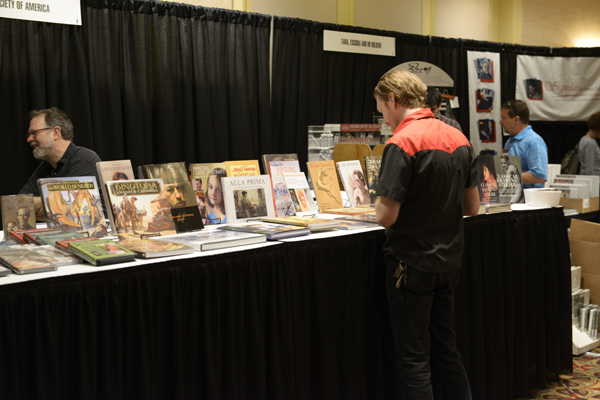 |
| The book table |
 |
| Jack Richeson & Co., Inc. |
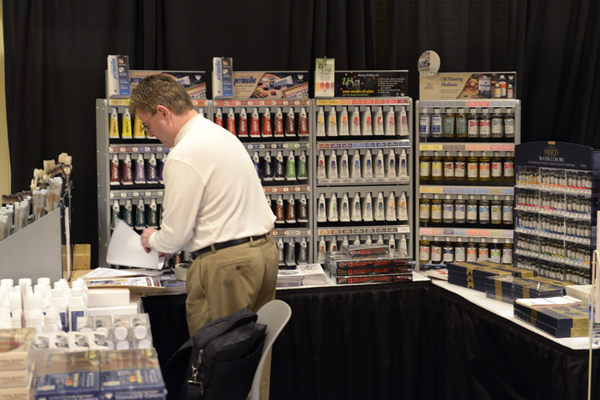 |
| Martin / F. Weber, Co. |
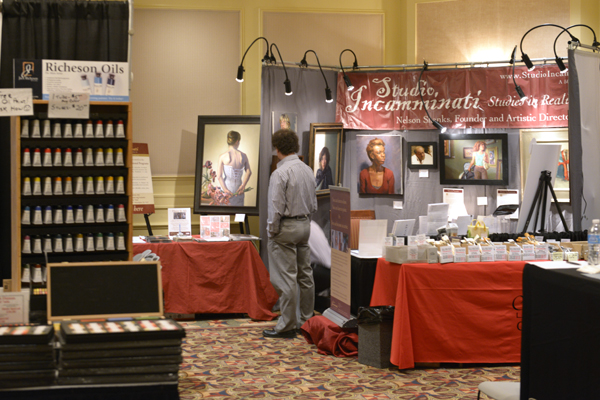 |
| Andrew Yannelli, Director of Education at Studio Incamminati, making final adjustments before the attendees arrive. |
 |
| Studio Incamminati's Executive Director Jay Pennie (standing), and Andrew Yanelli taking a break during downtime later in the weekend. |
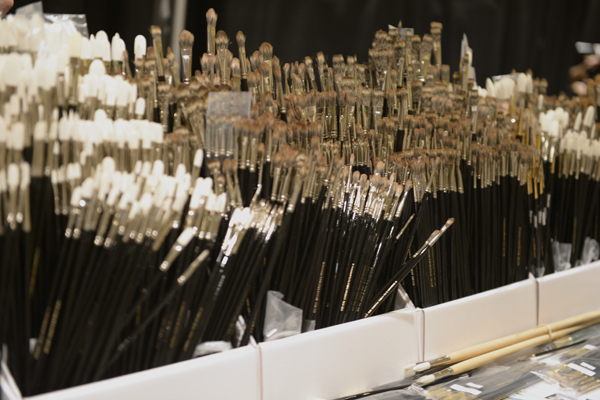 |
| Rosemary & Co. Handmade Brushes |
 |
| Silver Bush Limited boxed artist's sets |
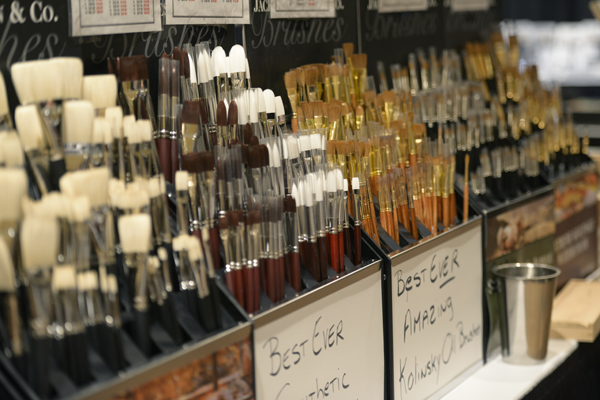 |
| Jack Richeson & Co.'s brush display |
 |
| Within minutes of the doors opening, the vendor room was packed with attendees. |
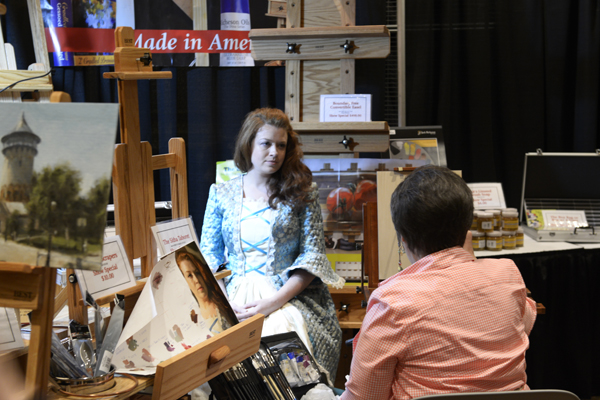 |
| Painting demonstrations in the Richeson booth |
 |
| Kyle O' Brien of New Wave Art Products helping a customer select a palette. |
So when I reached the New Wave Art Products booth intending to purchase another wooden palette - I now have four of these beautiful palettes and use them whenever I work - the appearance of newly manufactured items was too attractive to ignore. New Wave, a relatively young company run by Keith and Kyle O' Brien of Pennsylvania, has used high quality goods, and positive word of mouth between artists, to grow their company's reputation in a very short time. Their handmade wooden palettes, once available only directly from the brothers, are now sold in art stores throughout the country, including such places as Dick Blick and Binders. At the conference, however, available for the first time and not yet in retail stores, were two products generating a lot of interest among attendees. The first was an ambidextrous palette (the thumb hole features a reversible grommet that can be switched for use by either right or left-handed painters), cut in the same shape as the company's highly popular Highland palette. This new palette, the Easy Lift Peelable Artist Palette, is made of white plastic, and is less expensive than New Wave's wooden palettes. It also has the advantage of being both oil paint and acrylic paint friendly - in fact, dried acrylic paint just peels right off. And the second item which proved quite popular was their new line of neutral grey disposable paper palettes, available as both a rectangular pad, and as a palette pad, which they made in response to artist's demands. I picked up all three new items, not because I plan on shelving my wooden palettes, but because I thought these were the perfect fit for the needs of my young children who are just begining to paint.
This was a slight deviation from my budget, but I was still pretty much on target.
I then moved on to Silver Brushes, where I purchased the tiny Renaissance Sable Cat's Tongue brushes I enjoy using for detail work, the Tara, Escoda, and HK Holbein booth where I picked up some brush soap and a few a few Escoda brushes to try out, and then onto Rosemary and Co.'s booth, where I restocked on my Masters Choice Long Flatbrushes and also picked up several hog's hair bristle brushes, because I have been feeling more painterly lately, and it is time to lay down more paint.
Check, check, and check.
Next Jack Richeson tempted me with their pastels (they do look like candy laid out so beautifully in their boxes, don't they?), but I resisted - for now. (But they are already on next year's list).
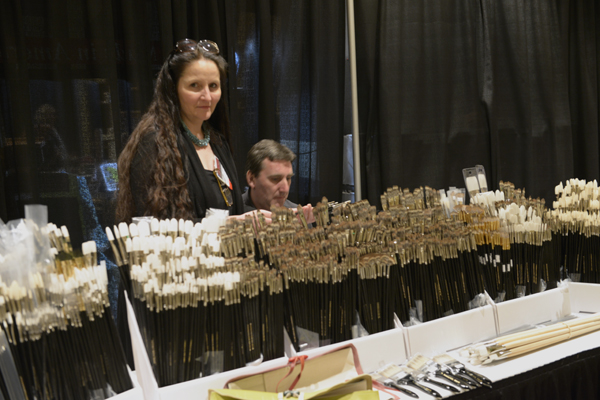 |
| Rosemary Thompson and her husband, Mark, after setting their booth. |
 |
| Five minutes later, Rosemary and Mark busily recording customer purchases. |
 |
| At the Natural Pigments booth, George O' Hanlon discusses his Rublev oil colors, while Tatiana Zaytseva (in background) helps a customer with Rublev watercolors. |
I was doing well, sticking to my resolve of controlling my spending. That was until I made it to the Natural Pigment booth.
As I have mentioned in earlier posts, my palette consists of paints made primarily by two manufacturers: Vasari Classic Arttists' Oil Colors, and Natural Pigments' Rublev line of oil paints. Both companies make exceptional paints, and for me, they complement each other very well. (Vasari was a sponsor of this year's conference, and I hope they some day participate in the vendor's room, though having so many great paints all in one place would probably cause me to pass out and miss most of the conference). I have almost the entire line of Rublev paints in my studio; I knew exactly what was depleted, and what four tubes I wanted to purchase at the conference, then I would put away my credit card, which would make my bank sad, but my wife happy.
And here is where I was stupid. I know George O' Hanlon of Natural Pigments, and George loves making discoveries. Why I expected to go to his booth and know exactly what he would have stocked and ready for sale is a mystery. The smart thinker would have known that Natural Pigments will always be expanding their offerings.
I expected to purchase a large tube of lead white, a tube of Roman Black, one of Burnt Cypress Umber, and one of red lead (Minium). That was my list. But then Tatiana Zaytseva, co-founder of Natural Pigments, pulled out Rublev Orange Ochre oil paint (an until-recently sold-out color) and tubed Genuine Naples Yellow (tubed!), and, I immediately added them to my basket. And then seeing the Rublev Verona Green Earth and the French Sienna color swatches on Natural Pigments' new wall display convinced me to buy two more items not on my original list. And next came the Italian Varnish and the Venetian Medium . . . and well, who could resist? It is not even that Tania and George are such great salespeople - they are passionate about their products, but they are really just there to answer questions and to offer suggestions based on immediate customer inquiries - it is that their products sell themselves. The funny thing was, after my buying frenzy, the one item I did not get at the Natural Pigments booth was the large tube of lead white (130 ml); in previous years, it had not sold well, so only the standard 50ml tube was on hand. Luckily, Natural Pigments, as well as many of the other vendors who were present, will grant attendees the same conference rates on items ordered online due to selling-out, or, as in this case, not having it at the booth; I ordered two 130ml tubes of lead white, and had them at my front door within a few days of returning home from the conference.
 |
| George O' Hanlon introducing artist David Gluck to the newly-made Rublev color charts, which offer a comparison of tints made from both lead white and titanium white. |
George O' Hanlon is, of course, as much of a draw for me in the exhibit hall as are all the products for sale. I always enjoy hearing what new chemical formulas and processes George has uncovered, and what he plans to bring to market, though I am so blown away by his knowledge that I often feel, when we are done conversing, that I have just gone through a rigorous college chemistry course. This year O' Hanlon told me of his success in making white lead, and how he plans to streamline the processing of the pigment using froth flotation tubes. These tubes allow for the separation of particles, with the desired aspect attaching to air bubbles and floating to the top of the tube where it forms a slurry, while the remainder sinks to the bottom (changing the chemical mixture in the tube can reverse which element adheres to the air bubbles and floats to the top). He also talked about his new facility and new prospects of preparing pigments from tinctures, including producing a new line of alizarin pigments in a variety of hues, not just crimson. Potentially coming up for the company is the production of a copal varnish which would rival or exceed the virtues of that once made from now-unobtainable African copal. It would be made using a process which was discovered prior to the 1940s, but which never found a viable market use, until O' Hanlon saw its potential for making a better art product. And this is only a small glimpse of what George has planned for the rest of this year (I had better take another chemistry class as preparation work before our next meeting at the 2014 conference).

